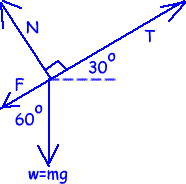Free-Body Diagrams
 A free-body diagram just shows the forces acting on that body - the diagram does not include the forces that the body exerts on other objects.
A free-body diagram just shows the forces acting on that body - the diagram does not include the forces that the body exerts on other objects.
Let us look at the following example question:
Look at the system shown on the right.
There a log is being dragged up a 30o slope by a cable, this cable being wound around a pulley by an electrical motor.
We want to calculate the tension in the cable if there is no friction. |
|
Step 1: You need to decide which object is going to be isolated in your FBD.
This object will have forces on it, that you are trying to find. |
In this example the object is the log.
We have to calculate the tension in the cable attached to that log.
To do that we have to consider ALL of the forces acting on the log. |
Step 2: Draw a sketch of this body.
 Dont be lazy, draw a neat sketch and include any angles you have been given... Dont be lazy, draw a neat sketch and include any angles you have been given...
The IMPORTANT thing is that you are completely isolating the object from its surroundings while representing EVERY force acting on it.
These could be reactions due to contact with external surfaces and bodies (F and N), applied pushing or pulling forces (T), and any weight force (mg).
Spend some time making sure you've included all forces. |
 For part (a) the only forces acting on the log are its weight (always vertically down!), the normal reaction from the ground and the pull of the cable. For part (a) the only forces acting on the log are its weight (always vertically down!), the normal reaction from the ground and the pull of the cable.

 For part (b) we have to add the friction (parallel to the slope). For part (b) we have to add the friction (parallel to the slope).
 |
 You now have a simplified diagram that includes all of the forces and angles you need to solve the problem - a free-body diagram.
You now have a simplified diagram that includes all of the forces and angles you need to solve the problem - a free-body diagram.


